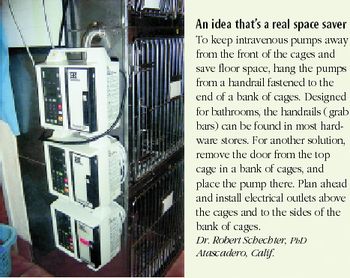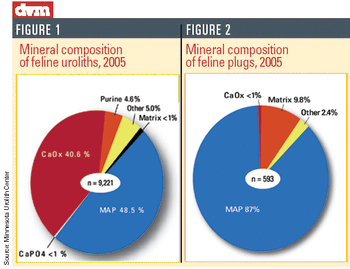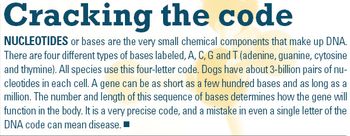
Unotron introduces SpillSeal? protected to IP66 and NEMA 4X standards washable corded optical mouse product line.

Unotron introduces SpillSeal? protected to IP66 and NEMA 4X standards washable corded optical mouse product line.

Orlando ? IDEXX Laboratories introduces a direct-to-digital radiography system for the companion animal market.

To keep intravenous pumps away from the front of the cages and save floor space, hang the pumps from a handrail fastened to the end of a bank of cages.

St. Charles, Mo. ? Royal Canin Veterinary Diet? launched a new line of dental diets for dogs and cats to help prevent dental plaque and tartar formation.

Dr. Dean Hendrickson, a veterinary surgeon at Colorado State University, is part of a team that has been performing vasectomies on wild elephants in overpopulated South African game reserves. The idea is to sterilize the dominant bulls, which will then breed with the female elephants without impregnating them.

Shark Lids introduces Medshields, disposable eyewear, the first optically clear, anti-fog, self-adhesive eye shield that is NFPA compliant, the company says.

Old Mother Hubbard introduces Super Mix? Puppy Formula in smaller-sized kibble.

Mast Technology announces an integration with Eponatech's Metron-PX software.

Allpro Imaging introduces ScanX 14, a digital imaging system designed for small medical offices.

MVP Laboratories introduces Emulsigen?, an oil adjuvant approved by the United States Department of Agriculture (USDA) for either intramuscular or subcutaneous injection of swine.

Abbott introduces AlphaTRAK?, a hand-held blood glucose monitoring machine designed for diabetic cats and dogs.

Las Vegas - A record crowd of 14,445 attended the 2006 Western Veterinary Conference; 6,860 DVMs and 1,664 technicians and technician students attended more than 800 hours of lectures, 20 symposia and 30 wet labs. The venue also welcomed 436 companies to the tradeshow floor.

Rebound Animal Health introduces Renurse? a milk replacer for puppies.

In 1981, calcium oxalate was detected in only 2 percent of feline uroliths submitted to the Minnesota Urolith Center, whereas struvite was detected in 78 percent.

Bryant, Lahey and Barnes introduces Multimin?, an injectable trace mineral supplement of zinc, manganese, selenium and copper as a way to quickly raise copper levels prior to superovulation.

Eclipse Press introduces Understanding Equine Hoof Care, a reference that includes a variety of topics, including cleaning, trimming, shoeing, types of shoes and common hoof problems.

Fort Dodge Animal Health introduces Innovator Rewards, a new equine disease protection plan.

Mila International introduces the Companion Port, which allows repeated access to the venous system.

Kane Enterprises, an Ag-Tek? Division, introduces a new line of paste supplements for a number of metabolic disorders in dairy cattle and small ruminants.

Washington - Year 2025: Technicians rank as spay and neuter experts, veterinary education and licenses restrict via species, and agricultural practice exists as a mere memory.

Spring. It's finally here. The daffodils are blooming. The hyacinths are up. The dogs come in almost every day with muddy paws, so I have semi-permanent footprints on the window sills where they peer out to see who's coming.

This month, we all benefit from Dr. Karen Tobias' dedication to teaching and bettering the standard of care in veterinary medicine.

Purina Pro Plan has reformulated its entire line of senior cat foods to address the changing nutritional and physiological needs of aging cats in two phases of the senior life stages.

Allpro Imaging introduces Provecta V, an accent digital intraoral sensor that incorporates Bluetooth technology and the ScanX 12 DVM digital processor.

Cleveland ? Universal Medical Systems Inc.'s Vet-MR Grande?, the first dedicated dual-purpose magnetic resonance imaging (MRI) system for all small and large animals, was unveiled at the North American Veterinary Conference (NAVC).

Feline Radio-Iodine Center introduces radio-iodine therapy for feline hypothyroidism, the company says.

Herndon, Va. - Creating a charitable fund for use within the practice is a good way to let client and veterinary practice dollars work within the community, says Dr. Bill Swartz of Clocktower Animal Hospital.

Securos announces the release of a new line of casting and splinting products OrthoCast and OrthoSplint.

Deoxyribonucleic acid (DNA), a.k.a. the molecule of life, harbors an estimated 20,000 to 200,000 canine genes hidden in the DNA across from 38 pairs of chromosomes, all contributing to health and disease. Sleuthing out defects along genes nucleotides, or base pairs, seemingly turns into a numbers game that can add up into the billions.

Neogen Corp. introduces DC&R disinfectant reported to effectively control avian influenza, the company says.